Crypto Academy / Season 3 / Week 6 - Homework Post for professor @stream4u - Let's Open The Blockchain.
Now to the lectures proper.
What is Blockchain and What are the types of Blockchains / Explain in detail the types of Blockchain?
What is a Blockchain?
A blockchain is a digitally created platform containing blocks linked up by chains. They contain encrypted data/information unable to be disbursed or decoded by hackers and this makes a blockchain secured making it a Decentralized platform. The activities/transaction of a blockchain is transparently seen or made available to every members or nodes of the blockchain by a Distributed Ledger Technology were every participants have access to the blocks data and are independently able to maintain this datas(DLT).
Each blocks in a blockchain contains nodes, therefore when transactions or new blocks are formed in a blockchain, the information/data are broadcasted to every nodes for verification and acceptance. It is important to know that when majority of the nodes/participants in a blockchain accept a created block then should block will be accepted to be chained to the other blocks.
Now miners are able to protect the blockchain by encrypting the block data by a means called Hash. The Hash is a mathematical representation of an alphabetically scripted words or sentence were no matter the length of the alphabetically scripted words/sentence the length of the hash does not change. It is worthy of note to know that when the hash starts from a number of zero that's it valid.
Below are some key words to be considered when talking about a blockchain.
Block
The block is the main constituent of the blockchain. It is a digital creation by miners which contains encrypted data's stored in them. This encrypted data also known as Ledger can not be edited after Creation which helps the blockchain maintain it's Decentralized nature because no one person can edit the stored data.
The blocks are linked up by chains which gives rise to the name, block chain.
The block contains three major characters. Which are;
- Data stored in the block
- A 32-bit number called NONCE, generated when a block is created
- A 256-bit set of alphanumeric characters called Hash. And this hash are peculiar to that particular block.
Nodes
The concept of nodes can be explained more using the consensus algorithm strategy. Being that the nodes are participants or participating computer available with a blockchain that do the work of validating, mining, and authenticating datas and blocks through mathematical and arithmetic evaluations. This activities of the nodes makes the blockchain maintain it's Decentralized nature.
Miners
The miners are the actual creators of blocks within a blockchain. This is done through the application of mathematical and arithmetic resolutions on a high-powered computers to Produce blocks. The miners work majorly with the Nonse, data and hash to mine a block.
Types of Blockchain
Public blockchain
As the name implies public Chain it is a blockchain were everything is made public and transparent. The public blockchain seeks to remove the problem of centralization in a system, making every participants validators of ledgers. It is known as the first blockchain and it helped publicize the Distributed Ledger Technology. The public blockchain had major Cryptocurrencies originating from them, such as the Bitcoin. The public blockchain uses the consensus such as the proof of work and proof stake as it reward method.
Advantages of Public Blockchain
Independence: the public blockchain offers every participants a Decentralized access to the system, thereby the activities of a participant is independent of an higher authorities decision or approval.
Transparency: the public blockchain is transparent in the sense that every released data or Transaction by a participant or node is encrypted and stored on the blockchain after it has been validated by any or all of the participants. This transactions or data can be accessed by any member of the blockchain.
Disadvantages of Public Blockchain
### Performance: The is problem of performance of a public blockchain, that is in terms of action delivery. This happens when more nodes joins into the blockchain. And then there is no restrictions of nodes joining the blockchain so this becomes a major problem.
Security: though the public blockchain is known to be secured to an extent, but if there is a compromise by some corrupt nodes and the corrupt nodes gain up to 51% of the computing power then the blockchain can easily be hacked.
Private Blockchain
Unlike the public blockchain were any one can come in and become a node also known as a permissionless blockchain, the private blockchain is not like that, it more of a smaller network, and a certain number of people are allowed in and to possess the computing power. The private blockchain also operate as a Decentralized entity in that it also uses the pear to pear transaction method but the scale of allowance and operation is much more smaller.
Advantages of Private Blockchain
Access control: unlike the public blockchain were any number of participants are allowed access to the block. The private blockchain controls the number of participants coming in to the blockchain and this in turn makes the chain more secured.
Performance: being that the number of participants are small, then this blockchain is sure going to be on a fast lane delivering transactions and information on a more faster rate.
Disadvantages of Private Blockchain
Trust: The problem of trust arises with the private blockchain, being that at a point it almost behaves like a centralized system. If the fewer nodes available on the chain becomes corrupt then this makes the block very vunureable to attack.
Auditability: auditing becomes a problem with the private chain since some entity can have more access to transacting information and participants can't act in an anonymous manner.
Hybrid Blockchain
The hybrid blockchain combines the activities of the Private blockchain she that of the public blockchain. The Hybrid Blockchain controls what information is to be released to the public and which is to be confidential. Transactions on the blockchain are not made public but can be accessed and verified when a participant wants to through entering into a smart contract.
Advantages of Hybrid Blockchain
Access control: the hybrid blockchain behaving like the private blockchain Makes access control possible in that the number of participants allowed into the blockchain are controlled and limited to a particular number needed by the blockchain.
Performance as the number of nodes can be controlled in the network the performance of the blockchain is sure to be optimum.
Disadvantages of Hybrid Blockchain
Transparency: since users don't have access to transaction data and ledgers as at when needed without entering into a contract then Transparency on the Hybrid Blockchain can be limited
Upgrading: upgrading becomes a problem since alot of members are not allowed mining at free will therefore the system can remain on a particular level for a long while.
Consortium Blockchain
The consortium blockchain also known as the federated blockchain has the Characteristics of the hybrid blockchain combining the functions of the private and the public blockchain. But then the consortium eliminate the power possessed by a particular entity Making the blockchain privately Decentralized, being that the access into the blockchain is controlled.
Advantages of Consortium Blockchain
Access control: this blockchain offers access control since it has the Characteristics if the private blockchain.
Security: it is more secured since the number of nodes gaining computing power is limited.
Disadvantages of Consortium Blockchain
- Transparency: it is less transparent because of the private nature of the chain being that there is limited access to data and transaction information.
What are the benefits of blockchain?
Benefits of a Blockchain
Below are the benefits of a Blockchain.
Security
The end to end encrypting nature of a block Chain data is helps prevent tampering on an already verified and stored data. Further more the blockchain gives participants security being that information/data on the block chain are not stored on a single computer but several of such which makes it Different for compromise.
Transparency
The distributed ledger Technology makes this subheads very possible, being that data stored in the blockchain are made available to every participants of the blockchain network at the same time. This stored data are presented in an immutable nature in that the available ledger though available for all cannot be edited there by preventing fraud.
Low transaction cost
Unlike the traditional financial system, the blockchain which handles most of the Cryptocurrencies offers it users a low transaction fee for making transactions within the blockchain.
Speed
The time stamp of recording of information, transaction and datas on the blockchain becomes reduced unlike the traditional financial system where days can be taken before a transaction goes through most of the times when the transaction is inter country.
Trust
Due to the fact that every nodes and participants have access and stake in authentication, validation, and mining of data and blocks there is a build up of trust by the participants and this inturn allows more Investment and commitment to the course of the blockchain.
Explain Blockchain Distributed ledger.
Blockchain Distributed ledger
The blockchain distributed ledger refers to the ability of the participants in a blockchain to have access to the Distributed multiple data/information that they can validate them when they want to.
The blockchain distributed ledger majorly takes away the centralization nomenclature of a system. Unlike the traditional financial system, were a central system has to validate a transaction before it is vetted and allowed to go through. The Decentralized system removes this constraints through the ability of the distributed ledger. And due to this the trust worthiness of the blockchain is increased.
The consensus algorithm is what plays in consonant with the distributed ledger Technology to bring about decentralization. The consensus is the in-depth of decentralization birthing the Distributed Ledger Technology. To Explain this, nodes available on the blockchain get broadcast of a newly created block or transaction. It is worthy of note that it the majority of the nodes available on the block do not validate the released data or mined block the such data will not be verified. But then the opposite is always the case when a particular group of nodes are corrupted and they possess 51% of the computing power then the vetting power relies in thier hands.
Therefore a blockchain operating with a complete Decentralized method need to look out for opposing nodes so to safe guard the blockchain from impending attack.
What Is Blockchain Double Spending and how Bitcoin handles this problem?
What Is Blockchain Double Spending
Double spending is mainly associated with digital currency like the Cryptocurency, were there is falsification or duplication of a digital currency and it can be used more than one's.
This is caused by a flaw in the blockchain were there is a compromise and then an attack is lunch thereby falsifying the already mined asset causing a double production of that same asset to be reused in the market. This has alot of adverse effect on the digital currency such as
- Devaluation of such currency compared to other commodity
- Undue inflation
- Excess supply in circulation causing fall of asset
- Reducing trust of participants.
Like the traditional currency the counterfeit production is a synonym to the double spending in digital currency, but this is particularly associated with the digital Currencies.
Different Types of Blockchain double spending
Race Attack: This attack occurs when an attacker sends two transactions which are contradictory. The receiver therefore proceeding to accept the payment without waiting for confirmation falls a victim. Thereby leading to double spending.
Finney Attack: this attack occurs when a participant of a Blockchain accept an unconfirmed transaction thereby giving the attacker an access for a double spending.
Vector 76 Attack: this is a type of attack were attackers take advantage of small fault in a Bitcoin blockchain system thereby seizing funds in-between and causing losses to victim.
How Bitcoin handles double spending
While double spending is a major problem faced by a blockchain, blockchain lunchers have also devised means to cub this menace and this can be seen as it is done on the Bitcoin blockchain.
Bitcoin uses the method of distributed ledger Technology and the transaction verification/, confirmation method to fast tract this set back.
Now assuming an attacker lunches an attack by sending the same number of Bitcoin say he/she had 1btc and send it two times, the transaction will remain in the pool as an unconfirmed transaction. The first transaction will then be confirmed by verification mechanism and then registered on the blockchain as verified transaction. The second transaction which is the same will be detected by the verification mechanism and would not be registered on the chain as valid transaction.
Practical + Theory, Visit Blockchain Demo and check section Blockchain, then explain in detail how Blocks Hashes Work in Blockchain, what will happen when any middle of the block gets changed, try to give screenshot for each possible details.
Blockchain Block Hash
Blockchain Hashing which involves the use of cryptographic algorithm to transcribe data or encrypt data on a blockchain making such data encoded and protected.
Now practically explaining this I visited Blockchain Demo and the below was derived.
Now looking at the above screenshot showing a 5 block mined blockchain starting from block one till block 5. Now if you looked at the 5 above blocks they are all valid with the correct hash and nonse.
The same repeats till block 5, were the present block carries the hash of the previous block which brings about the chain linkage the blocks.
The block one(1) contains a previous hash of 0's all through showing that that is the first block of the blockchain looking at that too the hash 1 has an hash which is
000015783b764259d382017d91a36d206d0600e2cbb3567748f46a33fe9297cf
The above hash shows 4 zeros from the beginning, it is worthy of note to understand that when an hash starts with four zeros such an hash is termed valid and this is done by miners by manipulating the Nonse till this four zeros is obtained thereby giving the valid hash.
Looking at the block 2 screenshot above, the previous hash has the valid hash of Hash 1 and the its own hash being
000012fa9b916eb9078f8d98a7864e697ae83ed54f5146bd84452cdafd043c19
Is also valid because of the four zeros in front.
It is worthy of note to understand that miners do the work of using highly powered computers to compute the Nonse till they arrive at an acceptable hash so to obtain a valid Block on a blockchain.
What will happen when any middle of the block gets changed?
Looking at the screenshot above I went to block one and then gave data to the block which was previously empty. I gave it Crypto Academy and immediately the entire blocks from 1 to 5 turned which entells that the just inputed data is invalid, causing an invalid Nonse and, previous hash and current hash so it is in the place of the miners to solve this problem and since I am the money in this case I'll try to solve this problem.
Now instead of manually trying to compute the hash and nonse to be correct so to give a valid hash, I just click on the mine below and it immediately corrects the hash giving it the Hash below
0000dcb88fb8ece4c9c81a8c37f649b134b069fdce863e525ee085120c4e699b
Looking at block 2 below
The hash of the previous block linked immediately to the second block which was invalid previously but now valid because of the just mined block 1 but then the block two main hash remains invalid so we have to also work on that to make the Hash valid. After clicking mine a new hash is formed as seen above.
This process is repeated for all the blocks so as to obtain a valid blockchain. This mining process that is carried out after a particular block is edited is what helps in the security of the block, the rest of nodes get alert that there's a validation to be carried out, so they either verify or not.
What Is Race Attack in blockchain? OR What Is Finney Attack in blockchain? OR What Is Vector76 Attack in blockchain?
Vector76 Attack in blockchain
The vector 76 attack which combines the Career Attack and Finney attack to execute it malicious cyber crime takes advantage of small fault in the Bitcoin network to validate transaction thereby causing a loss to the blockchain. The vector76 attack was first identified by a Bitcoin blockchain user with a username vector76 on the Bitcointalk forum.
How it is Executed
The attacker monitors the blockchain for two nodes that execute transaction fast then takes control of those two nodes interconnecting them strategically in order to execute his transactions. When that is achieved he/she then in isolation creates a block chain and wait for the blockchain to advertise for a new block mining then the attacker sends in the block with the two nodes he/she had taken control of say node A and B. Before sending in the block, the attacker will creat two Bitcoin transaction say 27btc and 0.2btc one bigger and one smaller. Then assigns the first transaction with the first node and the second transaction with the second node.
Then the attack first sends the first transaction with the block, the others nodes seeing the block seeking validation with an important node attached to it are decieved to think that it is a genuine block then proceeds to verify, as it verifies it also verifies the transaction that followed the block which was the 27btc.
The attacker immediately withdraws the asset from the block and sends in the second transaction 0.2btc for verification as a fork so the chain will be deceived to think that this is the main transaction and then rejects the first transaction which the attacker had already made a withdrawal from the network.
Limitations/disadvantages of Blockchain.
Disadvantages of Blockchain
Scalability
Scalability becomes a problem of the blockchain in that the major blockchain example the ones that uses Bitcoin known as the public blockchain do not control he number of nodes coming into the network and this in turn affect the overall performance or the network causing the network to slow down in performance and in turn causing transaction time to slow down too.
Much energy consumption
The mining process of a Blockchain needs much energy which might not be conducive to the real world. The complex mathematical algorithm solved by the miners to mine a block is what gives rise to this high energy consumption.
Immutability
We all know that one's a data has been verified ave stored in the blockchain it can't be altered again. And this can be a major problem.
Further more, when transactions has been processed, it the sender sent it to a wrong recipient, then such transaction can't be revoked be the blockchain.
Security
Although the blockchain is more secured than other networks it is not completely secured, in that if a node or participants has a possession of 51% computing power then such participant can attack the network successful.
keys misplacement
In cases were users miss thier access keys then such account is lost because no lost key can be retrieved since the system does not stored owners or users keys.
Conclusion
The blockchain can simply a network that tries to solve the short comings of the centralized system. It is a distributed ledger Technology that operate on a peer to peer bases with each peer having a full participation of the happenings of the network. The blockchain is a Decentralized system and that is the major Advantages.
Thank you


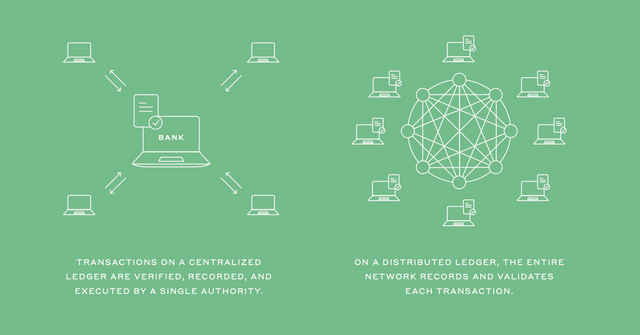
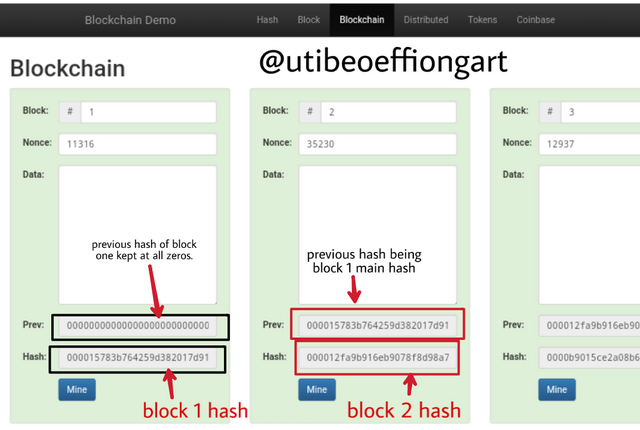
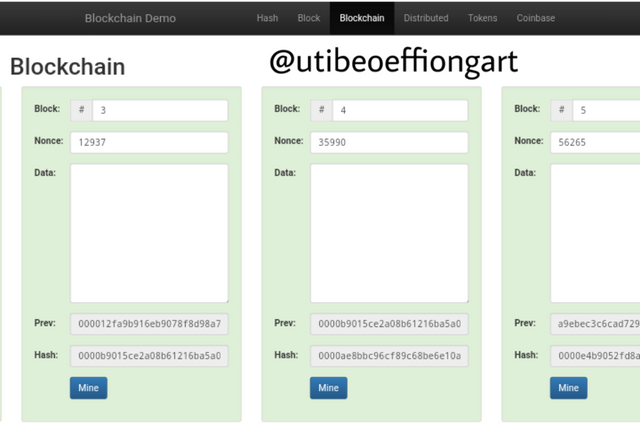
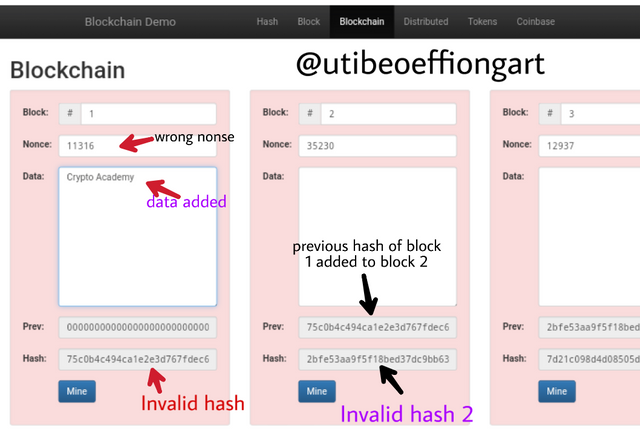
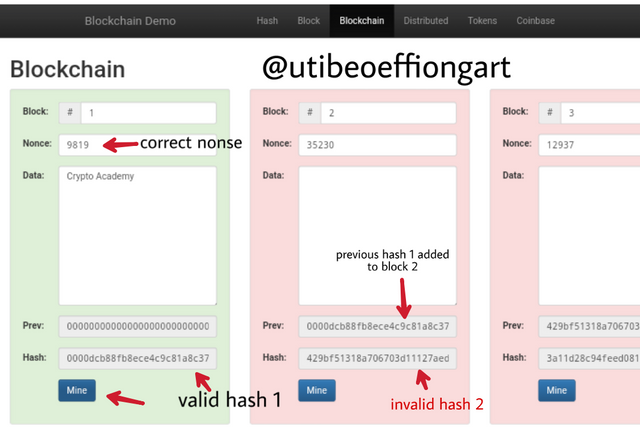
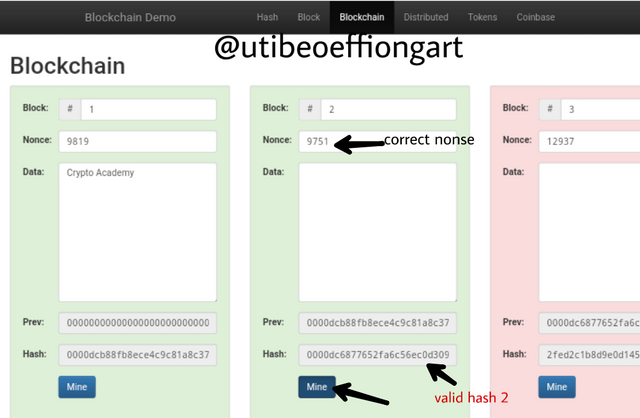
Hi @utibeoeffiongart
Thank you for joining The Steemit Crypto Academy Courses and participated in the Homework Task.
Total | 8/10
Your Homework Task verification has been done by @Stream4u, hope you have enjoyed and learned something new.
Thank You.

@stream4u
Crypto Professors : Steemit Crypto Academy
#affable
Good